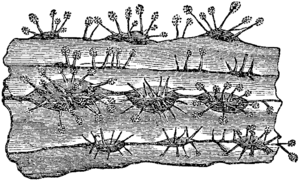Rosellinia necatrix facts for kids
Quick facts for kids Rosellinia necatrix |
|
|---|---|
 |
|
| Dematóphora necátrix [sic!], illustration #346 in M. Cilenšek: Naše škodljive rastline (1892) | |
| Scientific classification | |
| Genus: |
Rosellinia
|
| Species: |
necatrix
|
| Synonyms | |
|
Dematophora necatrix R. Hartig (1883) |
|
Rosellinia necatrix is a tiny fungus that causes a serious plant disease called white root rot. This fungus attacks the roots of many different plants, making them sick and sometimes even killing them. It was first officially described in 1904.
Contents
What is Rosellinia Necatrix?
Rosellinia necatrix is a type of fungus. Fungi are living things like mushrooms or mold, but this one is so small you can't see it without a microscope. It's known as a plant pathogen, which means it causes diseases in plants. Think of it like a germ that makes plants sick!
How it Harms Plants
This fungus is famous for causing a disease called white root rot. It gets its name because the roots of infected plants often turn white and fuzzy due to the fungus growing on them.
Here's what happens:
- The fungus lives in the soil.
- It attacks the roots of plants, which are like the plant's mouth and straw, taking in water and nutrients.
- When the roots are damaged, the plant can't get enough water or food.
- The plant starts to look unhealthy, its leaves might turn yellow, and it might wilt.
- Eventually, if the disease is severe, the plant can die because its roots are too damaged to support it.
Plants It Affects
Rosellinia necatrix is not picky! It can infect a wide range of plants, including many that we eat or grow in our gardens. Some of its common targets are:
- Fruit Trees: Apples, apricots, avocados, pears, and citrus trees (like oranges and lemons).
- Berries: Strawberries are also at risk.
- Other Plants: It can also infect cassava (a root vegetable), hops (used to make beer), and even beautiful Narcissus flowers.
Because it attacks so many different types of plants, it can be a big problem for farmers and gardeners around the world.
How Does it Spread?
This fungus mostly spreads through the soil. If a plant is infected, the fungus can live in the soil around its roots. When that plant dies or is removed, the fungus can stay in the soil, waiting for a new plant to infect. It can also spread through:
- Infected plant parts: If sick roots or soil are moved from one place to another, the fungus can travel with them.
- Water: Water can carry tiny fungal spores or pieces of infected soil to new areas.
- Tools: Garden tools that have been used on infected plants can carry the fungus to healthy areas if not cleaned properly.
Protecting Plants from White Root Rot
Preventing white root rot is very important because once a plant is infected, it's hard to cure. Farmers and gardeners use several methods to try and keep their plants safe:
- Healthy Soil: Keeping the soil healthy and well-drained can help.
- Removing Sick Plants: Quickly removing and destroying infected plants helps stop the fungus from spreading to others.
- Cleaning Tools: Making sure all gardening tools are clean before moving between plants.
- Choosing Resistant Plants: Sometimes, scientists develop plant varieties that are naturally stronger against this fungus.
By understanding how Rosellinia necatrix works, we can better protect our plants and ensure we have plenty of fruits and vegetables to enjoy!
See also
 In Spanish: Rosellinia necatrix para niños
In Spanish: Rosellinia necatrix para niños

